- Home
- Archive -May 2000
- New age hero

New age hero
- In :
- Personal Growth
May 2000
By Ajay Ahuja
Bestselling author, leading exponent of Indian spirituality in the West and a pioneer of mind-body health, Dr Deepak Chopra is the most easily recognised New Age ideologue
There’s a traffic jam outside Delhi’s Talkatora Stadium, the venue for a talk by Deepak Chopra, one evening in early summer. After an inordinately long wait—the discomfort compounded by the enervating heat—the traffic clears up, and it’s possible to proceed and find parking space.
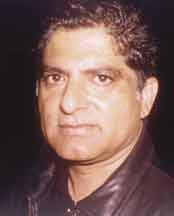 |
Outside the venue, a throng of believers, socialites and admirers of the New Age guru is being guided by uniformed security personnel towards the entrance. At a makeshift stall are displayed copies of Chopra’s books, including his latest, How to Know God. The line-up of parked cars extends half-a-kilometre on Shankar Road, running over the ridge.
Inside, the air is pungent with the odour of perfumes and colognes, as obviously well-heeled ladies and gents, often accompanied by their hip-hop teenage wards, move through the aisles looking for dwindling seating space in the already crowded auditorium. Are they here for the teaching? Or because it’s a social event?
Suddenly, Deepak Chopra, dressed in an immaculate grey suit, enters from the front of the hall. He steps into the VIP gallery facing the podium, and is immediately surrounded by fans. Soon, a television crew corners him for an impromptu interview.
Somewhat imposingly built, with suspiciously black hair and bushy eyebrows, Chopra looks the genial ‘neighbour-next-door’. Yet, by the time he takes the cordless microphone, the auditorium is packed to capacity, and even the aisles are crowded with invitees unable to find seating-space.
‘What I’m going to share with you is part of our cultural and spiritual heritage. It’s nothing new. So what you’ve really done is brought me here to remind yourselves of something that you already know.’ With this unexpected, but perspicacious, comment, he begins. His voice, rising and falling like the ebb and flow of the tide, resonates through the spacious hall as he recounts the contribution of India to world civilisation through the ages, in different fields of knowledge and activity.
‘India is the only country that, in 10,000 years, hasn’t invaded another country. Of course, it has invaded culturally. For centuries, it ruled South-East Asia, China, Japan through its mind, culture, science, cosmology and philosophy. Until the 17th century, India was the richest country in the world. There was no confusion about spirituality and materialism going together, because our Vedic tradition says that the four goals of life are artha (money), kama (desire), dharma (duty) and moksha (enlightenment).’
Facts and figures flow fast and furious at this stage. Some 6,000 years ago (he continues), when the rest of the world was living as nomadic tribes in dense forests, we had the Indus Valley civilization—with architecture, music, navigation, irrigation, and the art of government. The West talks of Machiavelli; what about Kautilya or Chanakya? Aryabhata was the first to suggest in the 5th century AD that the earth moves around the sun, not the other way round.
‘The world calls it the Copernican revolution; it should be called the Aryabhatan revolution,’ declares Chopra. And though the world calls Marconi the discoverer of wireless communication, it’s now recognised by scientists that actually Jagdish Chandra Bose was the pioneer of wireless. ‘India gave to the world the mother of all languages: Sanskrit. Recently, Forbesmagazine wrote that as we move from information technology to the technology of artificial intelligence, Sanskrit will be the language of the computer industry.’
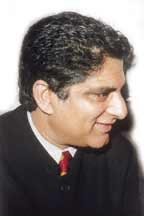 |
Having struck an immediate rapport with his listeners, giving them a dose of collective self-esteem, by the time Chopra concludes this part of his address, the audience is sold on him.
A gift for oratory and flair for words, coupled with a thorough grounding in the Indian tradition has helped him reach where he has. Chopra, the elder of two sons, was born into an ‘extremely Westernised’ family in New Delhi in 1947.
‘We didn’t notice anything exceptional about him,’ his father, Dr (Col) Krishan Chopra, a leading cardiologist, admits, ‘but Deepak was a gifted child.’ Wisdom in hindsight, perhaps?
Once, while going out, his father, who had two cars parked outside, asked three-year-old Deepak: ‘Which car would you like us to use this evening?’ Deepak replied: ‘These are your cars. Take the one you like. When I grow up, earn a lot of money, I’ll buy a big car.’ Precocious confidence?
In Pune, Chopra Sr decided to take his two sons, along with their friends, to the circus. However, Deepak, then four, refused: ‘I’m watching the birds and trees.’ His father told him that it would soon become dark. Deepak replied: ‘Then I’ll look at the stars.’ Intimations of immortality?
As a senior student in Delhi’s St Columbus School, Deepak was a good writer and an eloquent speaker. He wanted to be a journalist. However, later he changed his mind, qualified and got admission to AIIMS. His is a family of doctors, after all (uncle H.K. Chopra and brother Sanjiv are also doctors). But Deepak, says his father, was never one to follow the beaten track, not for long. While still at AIIMS, he saw the flaws in mainstream medicine. Once, he said: ‘I thought that they would talk about health, but they talk only about disease.’ It was probably the beginning of his disenchantment with the traditional mould of modern medicine. And a rediscovery of India.
‘Today, India is poised to contribute to the world in a way that, even with all its contribution in the past, it has not done so far. With its emerging domination of information technology, it will be an economic power in a world where economic, not military power will prevail.’
The biggest resources of wealth and power (says Chopra) are not outside, but in the human mind. As we have evolved, the sources of power and wealth have shifted. When we were hunter-gatherers, the only response humans had was to run or fight—we survived, but became experts at the fight-flight response. Seeking to protect ourselves against predators, we have become the predator. Homo sapiens is the only animal that kills its own kind, and most often in the name of God; that is ethnocentric, racist, bigoted and prejudiced; that goes to war; and that is destroying the ecological balance, the nurturing that we receive from Mother Earth. Yet, the human animal is the only one that asks himself questions like: ‘Where did I come from? What am I doing here? Is there any meaning or purpose to my existence? What happens to me after I die? Do I have a soul? Does God exist? And if God exists, does He care about me?’
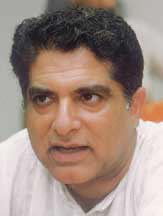 |
We are indeed a paradoxical species. And now we are faced with a choice: either we go the way of the predator, and risk our extinction like all predators, or join hands with the harmonious elements and forces of the universe, and chart a new evolutionary course. ‘All of classic science,’ declares Chopra, ‘even though it’s been extremely successful, has been based on a superstition: the superstition of materialism.’
Removing his jacket, to reveal a Chinese-collared black shirt beneath, he now cuts a striking, somewhat magician-like figure as he addresses the audience. The worldview of Newtonian physics, he explains, says: ‘The essence of reality is that it is material, we are part of the material world, the human body is material, and consciousness is an epiphenomenon, a by-product. If you think, feel, dream, imagine, have memories, desires—all this is a by-product of matter. Understand how matter behaves, and you will understand the mysteries of the universe.’ And today we are in the midst of the overthrow of the superstition of materialism, not necessarily because the world is becoming more spiritual, but because science itself is telling us that the essential nature of this material world is that it’s not material; that the essential nature of this physical world is that it’s not physical; that the essential stuff of the universe is non-stuff.
Today, you use e-mail or send messages on a fax machine or converse on a cellular phone—all these technologies are based on a fundamental premise of science, that the basic unit of matter called an atom is not a solid entity, it’s a hierarchy of states of information and energy in a huge void. Seen through the eyes of a physicist, the human body and everything that you experience as the material world is proportionately as void as intergalactic space. Krishna says to Arjuna in the Gita: ‘Let me give you divine eyes, and then you will see things as they really are.’ If you could see things as they really are, look through the eyes of quantum mechanics, everything is spinning out of nothingness at the speed of light.
The 13th century Sufi poet Jalaluddin Rumi said: ‘We come spinning out of nothingness, scattering stars like dust.’ Go beyond the appearance of molecules, you enter the subatomic cloud; go beyond the cloud, you end up with a handful of nothingness. And the crucial question arises, what is this nothingness from which we all come? Is it just a void, or could it be the womb of creation? What is the essential nature of reality? The great Vedic seers studied this question, and said: ‘Reality is different at different levels of awareness.’ Science is recognising this today. ‘I’m walking this road, not necessarily because I want to get somewhere, but because I enjoy walking this road.’
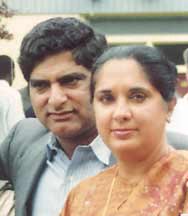 |
Having graduated from AIIMS in 1969, Chopra migrated to the USA with his newly-wedded wife, Rita. (His brother, Sanjiv, followed soon after with wife Amita). After seven years of advanced training, which included positions at prestigious hospitals, Chopra began a private practice in endocrinology and internal medicine. The practice thrived; in addition, he became chief of staff at New England Memorial Hospital in Stoneham, Massachusetts. He and Rita started a family and bought a home in the quiet, woodsy Boston suburb of Lincoln. By this point, Rita recalls, Deepak Chopra had ‘done it all’. ‘He’s always worked twice as hard as anyone else,’ she explains. ‘He puts his heart and soul into anything he does. And he’s always had a gift with people.’
Yet Chopra was getting restless. He smoked cigarettes, drank alcohol, and consumed plenty of coffee on his way through long workdays. He was counselling his patients to change their self-destructive habits, but began to recognize that he could not make such changes in his own life. Then came that fateful day. Browsing in a used bookstore one Sunday afternoon in 1980, Chopra stumbled upon a book on Transcendental Meditation. Reading the book that evening, he told Rita: ‘This looks fantastic!’
The following day they enrolled for a TM class and, two months later, they took the advanced TM-Siddhi programme. ‘At first I did TM mainly to relax, but it changed my whole life—my diet, my work, my relationships with patients and other people,’ he says. ‘I became 10 times more efficient in my work.’
He soon lost his taste for alcohol, and other self-impairing habits spontaneously fell away. His worldview began to change. “There are three ways of understanding reality,” says Chopra. “The least reliable is through the eye of the flesh, or seeing through our five senses. Till recently, science was an extension of the eye of the flesh. The second way, which is a little deeper, is through the eye of the mind. If I want to understand the Pythagoras theorem, quantum physics or the theory of relativity, I have to know the principles of Euclidean geometry or mathematics, that exist only in the mind. That takes me a little deeper into the heart of nature’s secrets. And the third way is through the eye of the soul. That takes us really into the heart and soul of reality. The visionary poet William Blake wrote: ‘We are led to believe a lie when we see with and not through the eye, that was born in the night to perish in the night, while the soul slept in beams of light.’
He was saying what’s becoming obvious to scientists today, that is, do not trust your senses. The great seers said: ‘The senses give us a partial view of reality—maya.’ It means creating something as a perceptual experience, which isn’t real—that you cannot trust. Chopra explains: ‘My senses tell me the earth is flat, it’s not true; my senses tell me that the ground I’m standing on is stationary, and I know it’s spinning at a tremendous speed and hurtling into space. My senses tell me that when I look at you, I see a three-dimensional body, an anatomical structure fixed in space and time, and that’s not true. It’s an illusion.’ The Vedic seers said: ‘Look at the human body as a river, and just as you cannot step into the same river twice, because new water is flowing in, the real you cannot step into the same flesh-and-bones twice.’
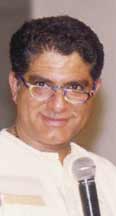 |
“Because every moment you’re actually changing your body, reshuffling, exchanging its atoms and molecules with the rest of the universe, and you’re doing it faster than you can change your clothes. In fact the bodies, which you’re using right now to sit on the chairs, are not the bodies that you came in with a little while ago.” Walt Whitman wrote: ‘Every atom that belongs to you as well belongs to me.’ And this is not a poetic metaphor, it’s a fact. So if you think you are your material body, you certainly have a bit of a problem: Which one are you speaking of?
The defining moment arrived in Dr Chopra’s life in 1985, when he met Maharishi Mahesh Yogi, founder of the TM movement, who had come to Washington DC for the inauguration of Maharishi Vedic University. Chopra and Rita were emerging from a dining room when they saw Maharishi, who walked straight up to them and asked them to come to his room. The Chopras were somewhat taken aback; they were scheduled to catch a plane in 15 minutes, and tried to beg off. But at Maharishi’s insistence they went upstairs, forgot all about their flight, and spent an hour talking with him. ‘I was impressed by his and my total comfort and the lack of formality. There was no pretentiousness, a lot of jokes and laughter. It was a light-hearted meeting,’ Choprarecalls.
‘And I was completely taken in by his sincerity, his almost childish enthusiasm… for lack of a better word, his bliss.’ Rita says: ‘Maharishi was the sweetest, easiest person in the world to talk to, so warm and friendly, so loving and happy. It was the most joyful experience.’ Maharishi spoke to Chopra about ayurveda, the 7,000-year-old Indian ‘science of life’, which Maharishi was reviving and purifying as an approach to perfecting health in the modern world. He told Chopra that he should study ayurveda, understand it, and explain it in scientific terms. In essence, he was suggesting that Chopra change the direction of his career, an idea that made Rita momentarily uneasy. She told Maharishi that it was not too practical for Deepak to devote himself to ayurveda; he had to make a living. Maharishi simply laughed and, eyes twinkling, assured them both that Deepak would be very successful with ayurveda.
Prophetic words, indeed. Dr Chopra is, today, the leading exponent of holistic health, New Age spirituality and human potential. His 25 books, including Ageless Body, Timeless Mind; Creating Affluence; The Seven Spiritual Laws of Success, The Return of Merlin and The Path to Love have sold more than 10 million copies worldwide. His latest work, How to Know God is also slated to be a bestseller. His website, like his television serials, enjoys top popularity ratings; his celebrity clients include Demi Moore, George Harrison, Michael Jackson and Oprah Winfrey; his Chopra Centre for Well Being at La Jolla, California is a pioneer in mind-body health; his lectures are hugely attended worldwide. His teaching blends physics and philosophy, ayurveda and modern medicine, timeless wisdom and personal insight with dynamic results.
His story echoes his words: ‘Life is a field of infinite possibilities.’ But growth is an ongoing process; in time it took him away from Maharishi. On Guru Purnima in 1990, Maharishi indicated he was uncomfortable with Chopra, who he felt was too eclectic. Chopra moved away to chart his own course. ‘I am too free a person to belong to an organization,’ he says. ‘I also wished to explore my creativity.’
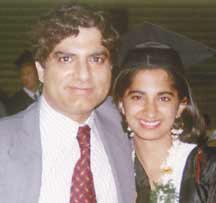 |
“There’s a deeper level of reality,” says Chopra. Science calls it quantum reality. Quantum in physics defines the smallest indivisible unit of information and energy. So a quantum of light is a photon, a quantum of gravity is a graviton. Our thoughts are also units of information and energy. When energy has a pattern, it becomes information.” To improve on Einstein, ‘energy and matter and information are interchangeable.’ In the quantum world we are inseparable, interconnected. Gautam Buddha said: ‘We are inter-beings that inter-arise in the inter-isness.’ We had known for thousands of years that at another level, the quantum level, we are inseparably connected. We are fields of energy and information in the universe of energy and information, where everything is happening at the speed of light. Your body, which appears to be physical is actually flickering in out of the infinite void at the speed of light. So here everything is indivisible, oscillating, has a wavelike frequency, and is spatially extended.
But the crucial question arises: where is this information and energy coming from? Quantum physics is giving us an insight. There are some fundamental premises of the quantum world: there are no objects, there are only superpositions of waves of possibility. things happen even faster than the speed of light. It’s called non-local action–one subatomic particle can communicate with another subatomic particle without sending it an energy or information signal. there are quantum leaps, which means a subatomic particle can be in one location, and then it can be at another location, without it having to go through the space in between. before you observe, nothing exists; the observer is necessary for the observation to collapse. In other words, those who understand this world say that at the most fundamental level of nature, one undivided consciousness collapses upon itself to create both the subject and the object of experience. In reality, the subject and the object, the seer and the scenery, the observer and the observed are the same being.
Recalling an insight of Vedanta, Chopra says that when one experiences samadhi, the seer and the scenery become one. This is the experience of unity consciousness, which is the ultimate truth at the heart of creation. And this is what really love is. Love is not a mere sentiment, an emotion, but the ultimate truth at the heart of creation. That truth is that the seer and the scenery, the observer and the observed, the knower and the known, the lover and the beloved are the same consciousness collapsing upon itself and experiencing itself as the observer and the object of perception. J. Krishnamurti often said: ‘The observer and the observed are one.’ If we can understand this fundamental truth, we will, to quote Krishnamurti, have a ‘mutation in consciousness’. And once that happens, nothing will ever be the same again. Your perceptual and cognitive mechanisms will change. You’ll not experience the same world ever again. That’s what we need—to go beyond the eye of the flesh, to go beyond the eye of the mind, and experience the world through the eye of the soul.
Yoga Vashishta said: ‘Let us understand, not just intellectually but experientially.’ And once we do that, the world will transform.
Chopra’s brother, Sanjiv is professor of medicine at the Harvard University School of Medicine. Amita is a paediatrician at the university’s hospital. Chopra’s wife, Rita, is primarily a housewife. Their daughter, Mallika, who married an NRI in Delhi two years ago, is working with Chopra’s website. Her brother, Gautam, who published a novella, Child of the Dawnsometime ago, is working with a news-based children’s television channel, which brings him to Asia quite often. Chopra’sparents reside in Delhi. Dr Krishan Chopra is consultant emeritus and member of the board of trustees of the Moolchand Khairati Ram Hospital.
Chopra’s success has led to the inevitable backlash. A report in the conservative political magazine, The Weekly Standard in 1996 alleged that there was ‘strong evidence that the guru to the stars has hired a prostitute.’ Chopra filed a $35 million libel suit against the magazine and reporter Matt Labash, which resulted in a retraction a year later and a settlement for an undisclosed amount. Chopra, in an unusual move, made a written appeal asking for public forgiveness for President Clinton, while the latter was embroiled in the controversy involving Monica Lewinsky. The letter entitled ‘Let him be: Clinton, sex and the courage of mercy’ was distributed by the Los Angeles Times Syndicate. Interestingly, Clinton, at a state dinner during his recent visit to India, said: ‘My country has been enriched by the contributions of more than a million Indian Americans, which includes Dr Deepak Chopra, the pioneer of alternative medicine.’ Talk of reciprocity!
Chopra, during his visit to India, also went to Mumbai, where he addressed a select gathering at a dinner hosted by the electronics giant, BPL, and gave an interview for the company’s website. He had a private session with Indian filmstar Amitabh Bachchan, who’s beset with problems on the business and career fronts. Shekhar Malhotra, Full Circle, says: ‘We are publishing a book of poems, Once When I Was a Child, the first by Chopra. He says he composed the poems in an unprecedented phase of inspiration. We’re also releasing audiotapes of The Seven Spiritual Laws of Success and Sacred Verses, Chopra’s commentary on the Bhagavad Gita.’
Poonam Malhotra of Full Circle says: ‘Chopra’s success can be attributed to his single-minded focus on spreading ancient Vedantic wisdom in a contemporary idiom and style. He draws from a variety of sources. People like you and me cannot read the original scriptures; he conveys their content to us. He appeals to the modern, logical mind; his path is of gyan yoga.’ She adds: ‘He is a warm and humble individual, without false airs. One senses a quietness within him. What he says, he practises.’
What is the great mystery of time? The universe, says Chopra, is cyclical. For instance, the earth spins on its axis and revolves around the sun: everything is inherently rhythmic. We create the experience of linear time because we cannot see the whole. It’s like standing on a circle, looking at distant places on the circle and thinking, ‘It’s a straight line.’ So the flow of linear time is actually a psychological event. For example, if you are in a hurry, you have deadlines to meet, you say, ‘I’m running out of time.’ And that makes your biological clock speed up–faster heart rate, high levels of adrenalin and stress hormones. And such a person, whose internal dialogue is constantly saying, ‘I’m running out of time,’ one day he’ll suddenly drop dead of a premature heart attack, he’ll have run out of time.
On the other hand, if your internal dialogue says, ‘I have all the time in the world,’ your biological clock will mirror that. Sometime we’ve all had the experience, when we were children and were playing, or perhaps we were in love, or listening to some great music, or in the stillness of samadhi—we slipped out of time altogether. When someone says: ‘The beauty of the mountain was breathtaking. Time stood still,’ that experience, where there is no time is, according to the great wisdom tradition of India, the experience of unity consciousness.
That’s when the observer and the observed, you and the mountain have become one. Stephen Hawking in A Brief History Of Time says: ‘We live in a universe that has no beginning in time. We live in a universe that has no ending in time. We live in a universe that has no edges in space.’ Try to visualise that. Your mind will reel in bewilderment. How do you imagine something that never began? And the moment you try and compromise, and say, ‘Perhaps there was a beginning,’ your immediate dilemma is, if there was a beginning, what was there before the beginning? If there is an ending, what is there after the ending?
If there are edges in space, what is there after the outermost edge? Our new physics is not only stranger than we think it is, it’s stranger than we can think. Yet all this was outlined subjectively in the Vedantic tradition. Lord Krishna, when he speaks to Arjuna about the essential nature of reality, says: ‘It has no beginning in time, it has no ending in time. Water cannot wet it, wind cannot dry it, fire cannot burn it, and weapons cannot shatter it. Unborn, it cannot die.’ He is talking a few thousand years before Stephen Hawking and Einstein. And he’s not only saying this is the essential nature of reality, he’s saying this is your essential nature.
To read more such articles on personal growth, inspirations and positivity, subscribe to our digital magazine at subscribe here
Life Positive follows a stringent review publishing mechanism. Every review received undergoes -
- 1. A mobile number and email ID verification check
- 2. Analysis by our seeker happiness team to double check for authenticity
- 3. Cross-checking, if required, by speaking to the seeker posting the review
Only after we're satisfied about the authenticity of a review is it allowed to go live on our website
Our award winning customer care team is available from 9 a.m to 9 p.m everyday
The Life Positive seal of trust implies:-
-
Standards guarantee:
All our healers and therapists undergo training and/or certification from authorized bodies before becoming professionals. They have a minimum professional experience of one year
-
Genuineness guarantee:
All our healers and therapists are genuinely passionate about doing service. They do their very best to help seekers (patients) live better lives.
-
Payment security:
All payments made to our healers are secure up to the point wherein if any session is paid for, it will be honoured dutifully and delivered promptly
-
Anonymity guarantee:
Every seekers (patients) details will always remain 100% confidential and will never be disclosed

After his Seven Spiritual Laws of Success, people expect Deepak Chopra to dole out lists and ways and tips. He had one ready at the Delhi talk.1. Change your perception of your physical body. Your body is a field of information and energy. This field is constantly influenced by breathing, eating, digestion, metabolism, elimination, and how we experience the world through our five senses. Also, how we metabolise that through our inner world of thought, feeling, emotion and desire.
2. Change your perception of time. If you can do that, you can accomplish much more—because you are creative, not stressed. You can do a lot more if you can sit back, become non-reactive, and see the world as if for the first time. Lord Shiva, the first yogi, said: ‘If you want to create a new body, step out of the river of memory and conditioning, and see the world as if for the first time.’ He said: ‘I use memory, but I do not allow memory to use me.’ Now change your perception of time, you have all the time in the world. Time is the movement of consciousness—put your attention on that, it’s timeless. And what is timeless? Not the human body, not the human mind, but the soul.
3. Change your perception of ageing itself. To grow old is to be wiser. To grow old is to have more responsibility. To grow old is to change your inner dialogue from ‘me, mine’ to ‘What can I do? How can I help?’ And as you change your perception of ageing, your biology will change. Those are the three most important things.
4. Keep active, exercise.
5. Improve mind-body coordination through yoga, breathing techniques, martial arts.
6. Get rid of the toxicity in your life—toxic emotions, relationships, habits.
7. Pay attention to literature—on nutritional supplements, ayurveda and all these great rasayanas, which are some of the great anti-oxidants known that directly affect the ageing process.
8. Learn to be flexible. Vedanta says: ‘Infinite flexibility is the secret of immortality.’ Studies show that the primary thing that distinguishes healthy older people from those less healthy, is the ability to be flexible.
9. Make love the most important thing in life. To understand our ‘inter-beingness in the inter-isness’, to understand love not as a mere emotion or sentiment, but as the ultimate truth at the heart of creation.
10. Be aware of your mortality, because in the awareness of mortality is the glimpse of immortality. Be aware that death is stalking you in every moment of your existence. And once one becomes aware of that, one’s life becomes magical. Because now one’s priorities are not the same.